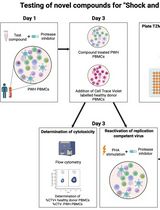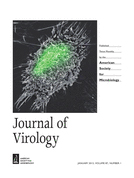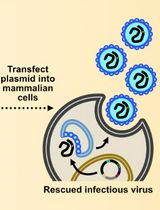- EN - English
- CN - 中文
Establishment of a Human Cell Line Persistently Infected with Sendai Virus
持续感染仙台病毒的人细胞系的建立
发布: 2017年08月20日第7卷第16期 DOI: 10.21769/BioProtoc.2512 浏览次数: 9018
评审: Yannick DebingAnonymous reviewer(s)

相关实验方案

诱导型HIV-1库削减检测(HIVRRA):用于评估外周血单个核细胞中HIV-1潜伏库清除策略毒性与效力的快速敏感方法
Jade Jansen [...] Neeltje A. Kootstra
2025年07月20日 2395 阅读
Abstract
Interferon regulatory transcription factor 3 (IRF3) is a transcription factor that upon activation by virus infection promotes the synthesis of antiviral genes, such as the interferons (Hiscott, 2007). In addition to inducing genes, IRF3 triggers antiviral apoptosis by RIG-I-like receptor-induced IRF3 mediated pathway of apoptosis (RIPA), which is independent of its transcriptional activity. RIPA protects against lethal virus infection in cells and mice (Chattopadhyay et al., 2016). In the absence of RIPA, caused by genetic ablation, chemical mutagenesis or inhibition of the pattern recognition receptor (PRR) retinoic acid-inducible gene I (RIG-I), Sendai virus (SeV) infection does not trigger cellular apoptosis and become persistently infected (Peters et al., 2008; Chattopadhyay et al., 2013). IRF3-expressing wild type (WT) cells (U4C) undergo SeV-induced apoptosis; however, the P2.1 cells, which are deficient in IRF3 expression are not capable of triggering viral apoptosis (Figure 1). Ectopic expression of human IRF3 restores the apoptotic activity in P2.1 cells (P2.1/IRF3, Figure 1). SeV is used as a model for studying pathogenic human viruses, which are difficult to work with or require BSL3 facility. We have previously reported that both human and mouse cells can establish SeV persistence in the absence of IRF3’s apoptotic activity (Chattopadhyay et al., 2013). Here, we outline a detailed procedure for the development of a persistently SeV-infected human cell line (Figure 2), which continuously expresses viral protein and produces low levels of infectious viral particles.
Figure 1. SeV-induced apoptosis is IRF3-dependent. HT1080-derived cell lines (U4C, P2.1 and P2.1/IRF3) were infected with Sendai virus and three days post infection culture fields were photographed, scale bar represents 50 µm.
Background
IRF3 is essential for initiating antiviral defense mechanisms in host cells by way of promoting transcription of antiviral genes (Hiscott, 2007; Chattopadhyay and Sen, 2017). Upon recognition of viral dsRNA by PRRs in the cell, IRF3 becomes phosphorylated, dimerizes, and translocates to the nucleus, where it binds to the interferon-sensitive response element (ISRE), and promotes transcription of type-1 interferons, e.g., IFN-β. IRF3 is also critical for triggering apoptosis via a distinct pathway, which does not require its transcriptional activity. In a series of previous studies, we have discovered the pathway, which we named RIPA that triggers apoptosis in virus-infected cells. In RIPA, IRF3 interacts with BCL-2-Associated X protein (BAX), a pro-apoptotic factor (Chattopadhyay et al., 2010). Upon binding to BAX, IRF3 translocates to the mitochondria, and initiates a signaling cascade that ultimately promotes apoptosis (Chattopadhyay et al., 2010). In the absence of IRF3 or other components of RIPA, the cells establish viral persistence when infected with Sendai virus (SeV) (Peters et al., 2008; Chattopadhyay et al., 2013). These persistent cell lines are useful for studying the full anti-viral mechanisms of cells because the cells do not undergo apoptotic cell death. In the current protocol, we provide a detailed method to create a SeV persistent human cell line, which are defective in IRF3 expression. Viral persistence is common for many viruses, which efficiently antagonize the cell death pathways of the infected cells. An in vitro approach to study persistently infected cells will reveal ways to avoid the establishment of viral persistence. It will also be evaluated in future whether the absence of RIPA can be used as a tool to generate persistently infected cells using viruses of different lifestyles.
Materials and Reagents
- Materials
- Pipette tips (USA Scientific)
- 6 cm tissue culture plates (USA Scientific, Cyto-One, catalog number: CC7672-3359 )
- Cryovials (USA Scientific, catalog number: 1412-9100 )
- 1.5 ml Eppendorf tubes (USA Scientific)
- PVDF membrane (Bio-Rad Laboratories, catalog number: 1620177 )
- Autoradiography film (Denville Scientific, catalog number: E3012 )
- 6-well plate
- Pipette tips (USA Scientific)
- Cells
- U4C cells: these cells were generated from HT1080 cells and are deficient in IFN signaling
Note: These cells are maintained in DMEM containing 10% FBS, 100 international units of penicillin, 100 µg/ml streptomycin (complete DMEM). - P2.1 cells: these cells were generated from U4C cells and are deficient in IRF3 expression
Note: These cells are maintained in DMEM containing 10% FBS, 100 µg/ml penicillin, 100 µg/ml streptomycin (complete DMEM). - P2.1/IRF3 cells: these cells were generated by stably expressing human IRF3 in P2.1 cells and were selected under puromycin (1 µg/ml)
Note: These cells are maintained in DMEM containing 10% FBS, 100 µg/ml penicillin, 100 µg/ml streptomycin and puromycin (1 µg/ml). - LLC-MK2 cells (ATCC, catalog number: CCL-7 ):
Note: These cells are maintained in Medium 199 containing 10% FBS, 100 µg/ml penicillin, 100 µg/ml streptomycin.
Note: U4C, P2.1 and P2.1/IRF3 cells were generated in the authors’ laboratory and were described previously. See Chattopadhyay et al., 2010 and 2016. These cell lines are available from the authors upon request. - U4C cells: these cells were generated from HT1080 cells and are deficient in IFN signaling
- Viruses
Sendai virus (SeV) Cantell strain (Charles River laboratories)–this strain was originally obtained from ATCC (ATCC, catalog number: VR-907 ) - Reagents
- Dulbecco’s modified Eagle’s medium (DMEM) (Lerner Research Institute Central Cell Services, catalog number: 11-500p )
- Fetal bovine serum (FBS) (Atlanta Biologicals, catalog number: S11550 )
- Complete EDTA-free protease inhibitor (Roche Diagnostics, catalog number: 11873580001 )
- Cryoprotective medium (Lonza, catalog number: 12-132A )
- Phosphate-buffered saline (PBS) (Lerner Research Institute Central Cell Services, catalog number: 123-1000p )
- SDS-PAGE loading buffer (Laemelli) (Bio-Rad Laboratories, catalog number: 1610737 )
- 10x SDS-PAGE running buffer (AMRESCO, catalog number: 0783 )
- Protein assay dye (Bio-Rad Laboratories, catalog number: 5000006 )
- 10x transfer buffer (AMRESCO, catalog number: 0307 )
- Nonfat dry milk (Bio-Rad Laboratories, catalog number: 1706404XTU )
- Tris buffered saline with Tween-20 (TBST) (AMRESCO, catalog number: K873 )
- Antibodies
- Sendai Virus C antibody (generated in author’s laboratory) (Chattopadhyay, 2016)
Note: Another anti-SeV antibody from Abcam, catalog number: ab33988 may be used to detect the presence of SeV. - Goat-anti-rabbit secondary antibody conjugated with horseradish peroxidase was obtained from Rockland Lab (Rockland, catalog number: 611-103-122 )
- Sendai Virus C antibody (generated in author’s laboratory) (Chattopadhyay, 2016)
- ECL plus solution (Thermo Fisher Scientific, Thermo ScientificTM, catalog number: 80196 )
- Medium 199 (Thermo Fisher Scientific, GibcoTM, catalog number: 11150059 )
- Agar (BD, DifcoTM, catalog number: 214050 )
- Guinea pig red blood cells (Colorado Serum Company, catalog number: 30100 )
- Tris buffer (pH 7.4) (Affymetrix, catalog number: 22639 )
- 5 M sodium chloride solution (NaCl) (Affymetrix, USB, catalog number: 75888 )
- Triton X-100 (Sigma-Aldrich, catalog number: T9284 )
- Sodium orthovanadate (Sigma-Aldrich, catalog number: S6508-10G )
- Sodium fluoride (Sigma-Aldrich, catalog number: S6521 )
Note: This product has been discontinued. - β-Glycerophosphate disodium salt hydrate (Sigma-Aldrich, catalog number: G9422 )
- Sodium pyrophosphate (Sigma-Aldrich, catalog number: S6422 )
- Cell lysis buffer (see Recipes)
- Dulbecco’s modified Eagle’s medium (DMEM) (Lerner Research Institute Central Cell Services, catalog number: 11-500p )
Equipment
- Micropipettes (10 μl, 200 μl, 1,000 μl) (Eppendorf)
- SDS-PAGE and transfer apparatus (Bio-Rad Laboratories, model: Mini PROTEAN-II )
Note: This equipment is no longer available at manufacturer (also use the same machine for agarose gel). - Vortex (Thermo Fisher Scientific)
- Tissue culture incubator (at 37 °C with 5% CO2) (Thermo Fisher Scientific)
- Biosafety cabinet (Baker SterilGARD)
- Table top centrifuge (Eppendorf)
- Heating block (at 95 °C) (Benchmark)
- Rocker (Benchmark)
- Rotator (Labnet)
- Refrigerator (4 °C) and freezers (-20 °C and -80 °C)
- Autoradiography film processor (Kodak)
- Spectrophotometer (Benchmark)
- Liquid Nitrogen Tank Cryosafe CM2 (D.A.I. Scientific Equipment)
Procedure
文章信息
版权信息
© 2017 The Authors; exclusive licensee Bio-protocol LLC.
如何引用
Coakley, C., Peter, C., Fabry, S. and Chattopadhyay, S. (2017). Establishment of a Human Cell Line Persistently Infected with Sendai Virus. Bio-protocol 7(16): e2512. DOI: 10.21769/BioProtoc.2512.
分类
免疫学 > 宿主防御 > 人
微生物学 > 微生物-宿主相互作用 > 病毒
分子生物学 > 蛋白质 > 抗微生物分析
您对这篇实验方法有问题吗?
在此处发布您的问题,我们将邀请本文作者来回答。同时,我们会将您的问题发布到Bio-protocol Exchange,以便寻求社区成员的帮助。
Share
Bluesky
X
Copy link












